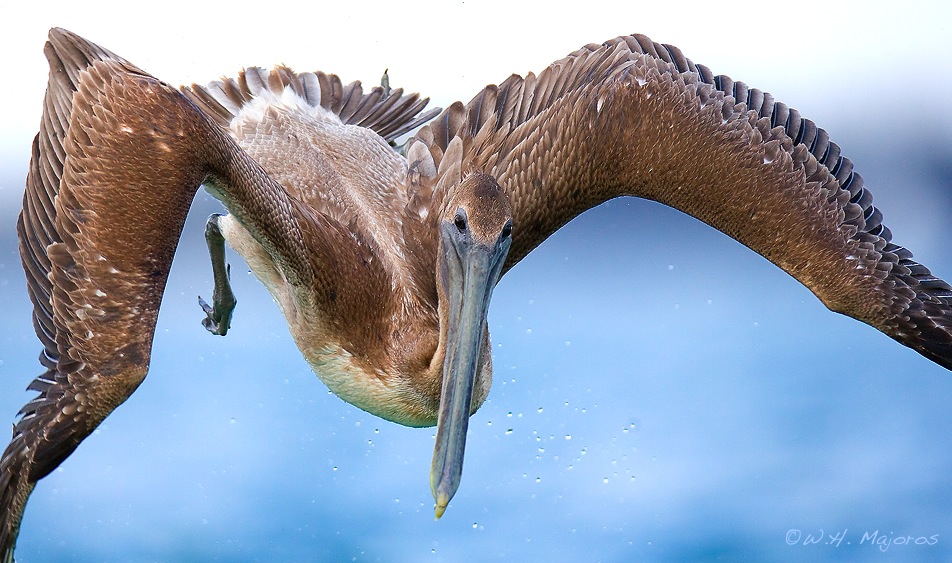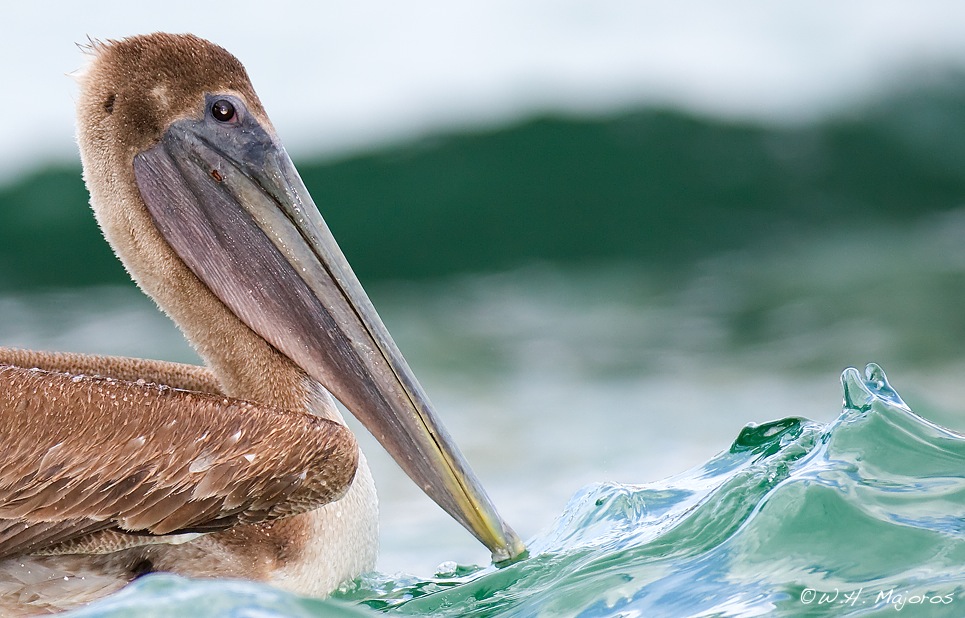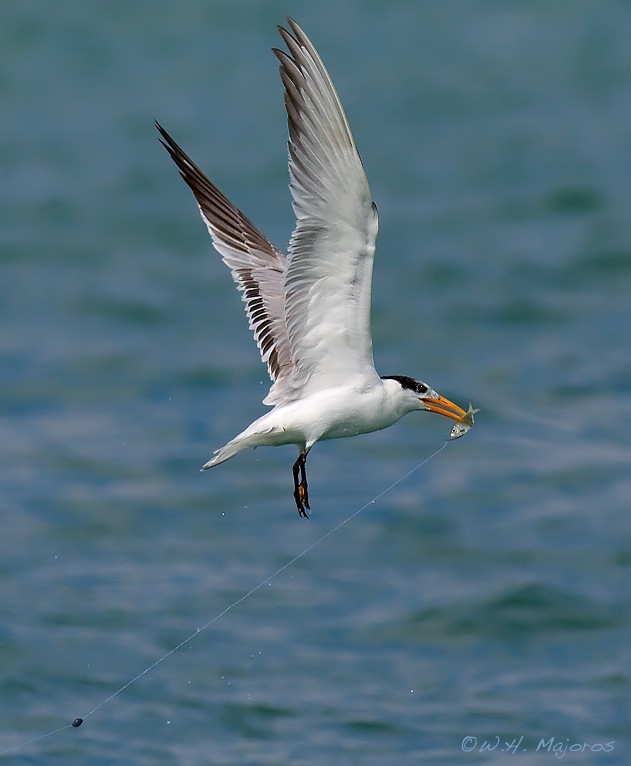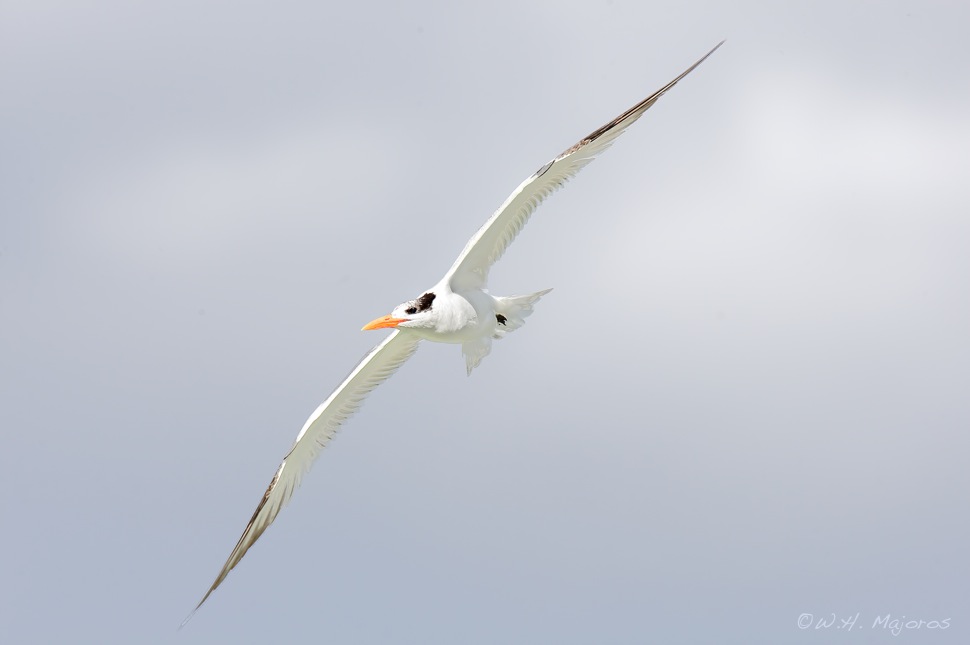March
6
Friday
1422
photos
|
Today
was fairly unproductive, partly due to my having caught a very, very
bad
cold, and partly due to the cloudy weather and the relative lack of
bird activity. I got to the pier on Sanibel fairly late in the
morning. The Pelicans weren’t diving close to shore as they had
been doing yesterday. Some were diving about a mile or so
offshore (too far to photograph), while a small group of others were
hanging around the pier, just floating around like ducks.
However, occasionally one would spot a fish or school underwater not
far away and perform what I call a "lazy dive": rather than rising to a
considerable height in the air and then performing one of the
spectacular dives I had witnessed many times yesterday, the bird would
lazily flap its wings just enough to rise a few feet above the water
and then perform an abbreviated dive into the water, head-first, with
most of the bird remaining above water throughout the dive.
Though much less impressive to watch, the fact that the birds were
doing this so close to shore (closer than they had been diving
yesterday) meant that there was the opportunity for getting some
closer-up shots of the birds in action:
 Pelican in "Lazy
Dive".
600mm at f/4. 1/3200 at ISO 1250.
No flash.
The above image is noteworthy for two reasons: (1) it was shot wide
open, at f/4, and (2) it was
shot at ISO 1250. In terms of the latter fact (the ISO setting),
this shows that Canon’s recent pro cameras (and undoubtedly Nikon’s,
too) are capable of producing images with exceptionally low noise at
fairly high ISO’s. I almost never take my Mark III any higher
than ISO 1250, and I rarely venture above ISO 800, but it’s scary to
think what the next generation of pro bodies will be capable of.
The fact that the above image was taken at f/4 is interesting for two reasons.
First, most lenses are sharpest at 1 or 2 stops below their maximum
aperture, so it’s remarkable to see a sharp image produced at full
aperture. Canon’s L-series lenses are reputed to be exceptional
in this regard, though I’ve remained skeptical on this point.
Second, with the exception of the proximal portion of the bird’s beak,
you can see that virtually the entire animal is in focus, despite the
fact that such a wide aperture (f/4)
should produce a relatively narrow
depth-of-field (DOF). The answer to the latter conundrum is that
DOF increases with distance to subject (as I’ve
mentioned several times already). This is why a pelican at
50 feet can be almost entirely in focus at f/4, while a shot of a
sanderling at 18 feet can feature fully out-of-focus foreground and
background at f/8.
Shooting
eye-level shots on my belly at the edge of the ocean was a bit
different from doing the same at the edge of a tidepool or stagnant
pond. In addition to having to worry about getting soaked by the
occasional far-reaching wave on shore (and possibly ruining my camera
or lens in the process —
as I did my iPhone last week), I had to time
my shots to coincide with the pattern of water around the bird.
Getting the bird while it was cresting a wave, without another wave
partially occluding the bird, and with the bird facing my general
direction, proved a bit tricky:

Pelican Cresting
a Wave off Sanibel.
600mm at f/5. 1/1000 at ISO 800.
Flash on high-speed sync at full power (+3).
I had the opportunity to get a rather closer view of a pelican today
than I expected. One of the birds got tangled in the fishermens’
lines, and got a hook embedded in its flesh. The fishermen lured
the bird in closer to shore and then caught it so they could remove the
hook. While two of them held the bird I aided in untangling the
bird and inspecting its wound after one of the others removed the
hook. There were just a few drops of blood and no real tearing of
flesh around the tiny puncture wound, so the fishermen declared the
bird "fine" and released it. I followed the bird by eye for a bit
to make sure it didn’t show any signs of injury or discomfort, but it
did indeed seem "fine", and resumed its lazy diving close by:
Brown Pelican on
Sanibel.
600mm at
f/5. 1/1000 at ISO 800.
Flash on high-speed sync at full power (+3).
Though the egrets were present again today
(on and off), there was much less activity, in terms of either
interactions or foraging. I decided to try for some portrait
shots on the beach, hoping for some novel backgrounds resulting from
the dimly lit ocean:
Snowy Egret at
the Fishermens’ Pier on Sanibel.
600mm at f/8. 1/640 sec at ISO 400.
Fill flash on high-speed sync at full power (+3).
I soon tired of that, but then discovered another source of background
color. Whenever a pedestrian approached, I carefully
positioned myself to put the bird directly between me and that person. As you can see, the skinny white bird stood out
starkly from the human behind it:
600mm at f/10. 1/500 sec at ISO 100.
No flash.
In late
afternoon a pair of terns started fishing near shore by the pier.
With the skies completely overcast, I once again found myself shooting
a white bird in front of a nearly-white background. Just keeping
the very fast-moving bird in focus was challenging, though my 1D Mark
III (a model reputed to have trouble tracking fast-moving subjects)
fared relatively well against this task:
Tern in Flight at
Sanibel.
600mm at f/7.1. 1/800 at ISO 500.
No flash.
The blurriness in this next photo (below) was due not to a faulty
autofocus
module in my camera, but due to a faulty photographer —
I obviously
needed a faster shutter speed than 1/800 sec to freeze the interaction
between these two amorous terns:
Tern Biting Tern.
600mm at f/8. 1/800 sec at ISO 500.
No flash.
I was glad too see, however, that I (and the Mark III’s autofocus)
nailed the one below —
those are the tips of a tern’s wings at full
plunge, and at 1/1600 sec the splash was well-frozen:
Tern
Impersonating a Submarine.
600mm at f/10. 1/1600mm at ISO 500.
No flash.
I should note that the camera didn’t always stay on target with the
plunging terns. Often, the AF would switch to the water behind
the bird as the bird got close to hitting the water. I had to
play with the settings to get it to stay on the bird during the full
plunge. Sadly, I don’t remember which settings gave me the
desired behavior, though I know I tried center point versus "ring of
fire" focusing, and I tried enabling and disabling the "expand with
nearby focus points" option, and one of these combinations did the
trick. So, the good news is that with the proper settings the
Mark III can deliver the goods, despite its long history of AF problems.
When the bird shown above emerged from the water and regained flight,
it was moving so fast that I could barely tell that it had a tiny fish
in its beak. It wasn’t until weeks later, when I viewed the full
image on my computer, that I realized the fish was on a "hook, line,
and sinker":

Beak, Line, and
Sinker.
600mm at
f/10. 1/1600mm at ISO 500.
No flash.
That’s twice in one day that I observed birds interacting with hooks
and fishing line. Nylon and steel are obviously not good for
birds —
I’ve heard of bald eagles dying after ingesting fish embedded
with hooks. In the case of pelicans and terns, this is a good
reason not to feed the birds in locations popular with fishermen, since
birds are easily conditioned to congregate in areas where there’s a
good chance of getting a free meal (as I saw last week on Key
Largo). The fishermen at the Sanibel pier told me they yelled at
some bird photographers just last week for feeding the birds; they
don’t like having the birds get tangled up in their lines any more than
we birders do. Given that the Sanibel fishing pier is
specifically
designated for fishing, it’s hard to argue that the fishermen should
stop fishing there. My recommendation to other birders and bird
photographers is to avoid feeding the birds at popular fishing sites,
for the sake of the birds’ safety. Even without our feeding them,
birds will continue to get hooked, but fishing as a recreational
activity is unlikely to ever die out, so there’s little else that can
be done.

Tern at Sanibel.
600mm at f/8. 1/800 sec at ISO 500.
Flash on high-speed sync at full power (+3).
By about 5pm I was exhausted —
my cold was making me feel miserable,
and the sparse birding opportunities were doing little to ease my
discomfort. I left early and headed to the Apple store to buy a
replacement for my ruined iPhone, which I had foolishly left in my
pocket while lying on my belly at Tigertail Beach...
|